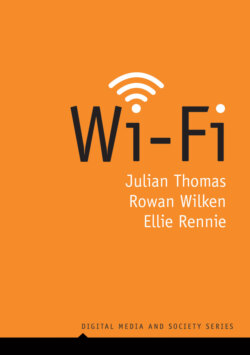Читать книгу Wi-Fi - Ellie Rennie - Страница 13
Overview of chapters
ОглавлениеWi-Fi is an ‘entangled infrastructure’. Our account of its social significance proceeds from the observation that its uses, and the debates these generate, are highly contextual. What Wi-Fi does and why it matters depends on where you are, in spatial, social, and institutional terms. So, in this book, we approach Wi-Fi across a series of different kinds of locations and at increasing social scales – the household, the community, the city. In all these contexts, we describe the transformative impact and animating potential of Wi-Fi as a distinctive form of infrastructure. We show how in different ways, Wi-Fi works not only as an occasionally essential digital service, but also as a powerful symbolic resource. Wi-Fi is an idea as well as a marketing phenomenon and technical construction, and much discourse about Wi-Fi retains a promise of the future, just as the memory of Jobs’s 1999 showmanship persists. Chapter 2 shows how Wi-Fi’s infrastructural dimensions and historical trajectories reveal a strong aspirational element. The proponents of Wi-Fi project ideas about communication possibilities: flexible, inclusive, inexpensive, grassroots technology, designed for the scale of households and communities. Wi-Fi’s symbolic power often works to expand digital participation. Public Wi-Fi fills gaps where other services fail, but it can also crowd out more ambitious strategies for an inclusive internet.
Our discussion then moves to the household. Internet scholars have written extensively about the domestication of certain technologies – the means by which they are appropriated and adapted into everyday life, and especially the private world of the home (Haddon, 2006). Those studies have rarely included close consideration of Wi-Fi, but in Chapter 3 we look at the continuing mutation of domestic Wi-Fi. Wi-Fi complicates standard accounts of domestic technology: we consider the ways in which, while being appropriated into the home, Wi-Fi itself may be said to domesticate households. In Chapter 4, we focus on initiatives at the level of communities, returning to the aspirational dimensions of Wi-Fi, examining the conditions of possibility for community networks, their modes of control, and the forms of agency they offer. Chapter 5 locates Wi-Fi in the urban history of communication, an addition to the enveloping ‘hertzian space’ of urban radio traffic. Urban Wi-Fi is a sharply contested space, where we find influential but sharply divergent visions for communication futures. These include competing understandings of ‘free’ Wi-Fi, municipal Wi-Fi, and the Wi-Fi-enabled ‘smart city’. We then conclude the book with reflections on Wi-Fi’s current problems and future prospects.
